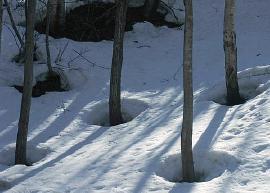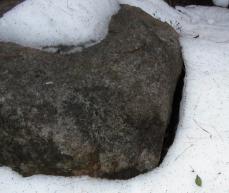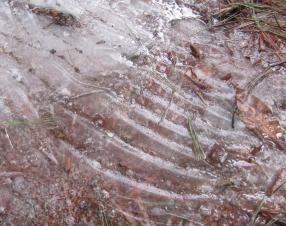 This past winter, I've come across some mysteries relating to snow and ice. These are things I don't understand, despite the opinion of some in my family that I know everything (see my sister Alice's guest blog entry, Ask Larry).
If this were water, and not ice, I wouldn't be at all surprised by the ripples on its surface. But it's ice, and ripples on the surface of water (caused by wind) can't abruptly be frozen in place. How can water freeze with a surface that's anything but flat? Any ideas as to how this can happen? Another strange phenomenon was caused by my habit of chopping up mounds of snow in the spring. I claim to do this to cause the mounds to melt more rapidly, but I think I just find it fun to get my revenge on large mounds of snow by chopping them up. It's also good exercise. A result is that I throw shovels full of snow in various directions. By the time I do this, the snow is fairly solidly frozen. This is not loose snow, so it ends up scattered on the ground in shovel-sized chunks.
But the chunks tend to develop "stalks" on their underside, on which they usually remain balanced. See an example to the right, but I knocked over a few that were even better, not realizing how interesting they were until I had destroyed them. Some were substantial chunks of snow, 20 cm or so across, exquisitely balanced on slender stalks. I'm not sure why, as these chunks shrink, their support tends to shrink in a way that keeps it directly under their center of gravity. Again, does anyone have any ideas? Here's another mystery: openings in the snow around tree trunks that I gather are called "tree wells". I stole the photo on the left below from the web, although it shows a rather extreme case (the gap between the tree trunk and the surrounding snow is usually only about five or ten centimeters).   The right-hand photo above shows a similar phenomenon occurring around a rock in my backyard (a rather expensive rock, I might add, chosen for its flat top, for sitting). Discussions on the web seem to indicate that there are differing opinions as to why tree wells occur. Trees are not warm-blooded (or should I say warm-sapped?), so I don't think they generate any heat on their own. The most plausible explanation seems to be that they are dark, and are warmed by the sun. A tree's branches, of course, may reduce the amount of snow that falls near the trunk. But it seems to me that would generate a wider area of less-deep snow, and the void wouldn't have such a sharp, mostly vertical boundary. In the science fiction novel Cat's Cradle, by Kurt Vonnegut, he introduced a form of water which he called "ice-nine. It was highly stable, solid like ice, but still a solid at warm temperatures. If a crystal of ice-nine was thrown into a glass of water, the result was to solidify the entire contents of the glass. This is all completely fictional, of course. But I've often wondered what people from warmer climates think when they visit new England, and watch the newscasters and weather-people on our television stations warning drivers about the possibility of "black ice". What do visitors imagine that "black ice" might be? Do they think that there is another form of frozen water that somehow they've never heard of? Television presenters never explain what they are talking about. They assume that all of their listeners know exactly what it is. But I'll explain what it is, for the benefit of readers who might not know - probably readers from tropical climates that never have to worry about ice on the roads. You probably know that the so-called "black boxes" carried by aircraft, the flight data recorder and the cockpit voice recorder, are actually orange in color, and not black. Similarly, black ice isn't black either. Black ice is clear. So what's so special about it? The reason black ice is worthy of note is because most ice found on roadways is not clear. Generally, road ice is whitish in color, and hence is not that hard to see. This is because ice on roadways is usually packed snow, leaving it a dirty white. Alternatively, puddles on the road can freeze into ice. But as water freezes, bubbles of dissolved air come out of it, and get locked into the ice. These bubbles also give the ice a white appearance - most of the ice you freeze in your home freezer will exhibit trapped air bubbles. But there are conditions which can produce perfectly clear ice on a roadway. This can be the result of freezing rain, which deposits the ice in thin layers which can't hold air bubbles. It can also be the result of ice from which the air has been driven out by a previous freeze-thaw cycle. In that case, since the dissolved air has already been driven out by the first freeze, the ice will be perfectly clear when it freezes a second time. And perfectly clear ice can't be easily seen, particularly at night. At night, your headlights bounce off it at a shallow angle, rather than being reflected towards you. In the daytime, since it is clear as glass, what you see is the asphalt pavement underneath. In either case, the ice appears black, hence its name. And since you can easily fail to see it, it's extremely dangerous. I'll close with one more photo, an example of the sort of thing one sees as the snow melts each Spring. It's a mouse tunnel, revealing the invisible activity that goes on under the snow all during the winter.    Note 1: "Sublimation" is a process by which ice, at below freezing temperatures, can transition directly into water vapor without first melting into water. You can think of the ice as evaporating, except the term "evaporation" is specifically defined as a transition from a liquid phase (in this case, water). [return to text]  |

